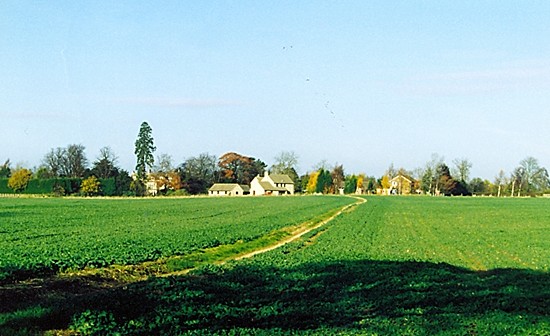|
- The villages around Bourne, Lincolnshire, England - |
Cawthorpe

|
- The villages around Bourne, Lincolnshire, England - |
Cawthorpe

|
THE TINY HAMLET of Cawthorpe is barely more than a dozen houses and the road
through it leads nowhere but peters out into a cart track to surrounding
farmland and then becomes a footpath into Bourne Wood and the countryside
beyond. The buildings range from red brick to stone and at the far end is a grand Victorian mansion known as Cawthorpe Hall, partly hidden behind a stone wall and looking at its majestic best in the morning sunshine on a summer's day. The house, built in 1819, was later the home of Robert Gardner, the Bourne bank manager turned artist, who lived here until he died in 1926 and he added a large studio with great atelier-style windows to catch the light for his painting. There is another imposing property in the village called Cawthorpe House, stone built and dating back to the late 18th century, although the foundations may have been laid in Tudor period when the property was merely a cottage and a date engraved on one of the outhouses puts the construction at 1723 while a date over the door of the main house is 1804 and accompanied by the initials JH. John Lely Ostler was living at Cawthorpe House by 1854 but he died in 1859 and a memorial drinking fountain was erected in Bourne market place as a mark of his philanthropy. The land has since been dispersed to various owners. The village is mentioned in the Domesday Book in which it is referred to as Caletorp but there are subsequent spellings of Calthorp and Calethorp and all originate from the Scandinavian meaning Kali's secondary settlement. One thousand years ago, this was a place of dwellings occupied by peasants and surrounded by open fields and much land in the area was owned by Oger the Breton whose holdings in the great land survey of 1086 extended to around 400 acres, known by such names as Cawthorpe West Field, Haseland Field and Quinto Field. Today, farming remains the main occupation in the village although some of the new houses that have been built are owned by people who work elsewhere. Cawthorpe never had a church but a mission house was established here in the 19th century for regular Sunday services by the Church of England who were anxious to establish a foothold in the outposts of the parish and this was still operating in 1937. The wide verges on the approach road from the main A15 were once a popular parking place for travelling families but they have been discouraged in recent years by the planting of shrubs and trees. |
Return to HOME PAGE MAIN INDEX
![]()